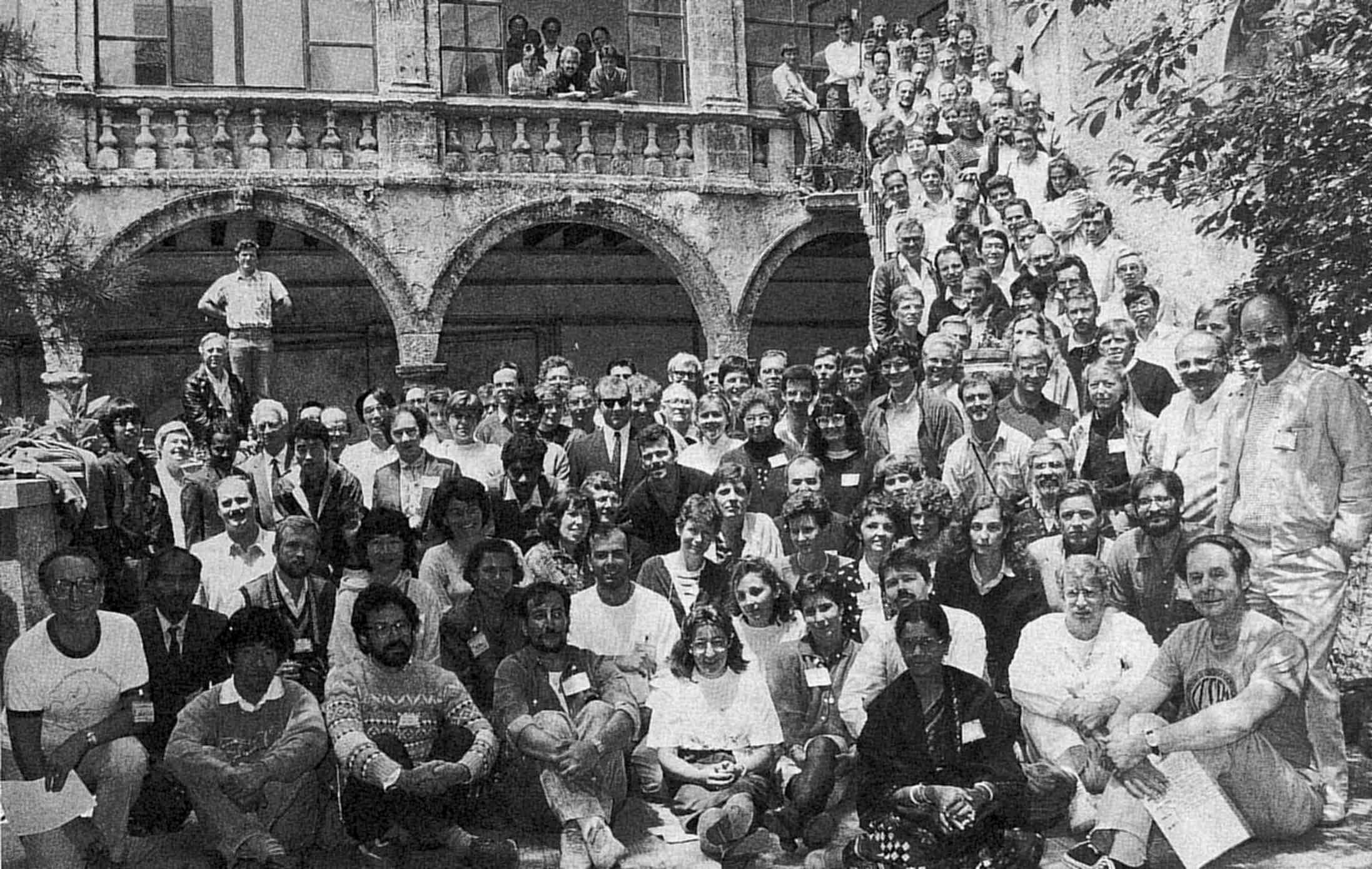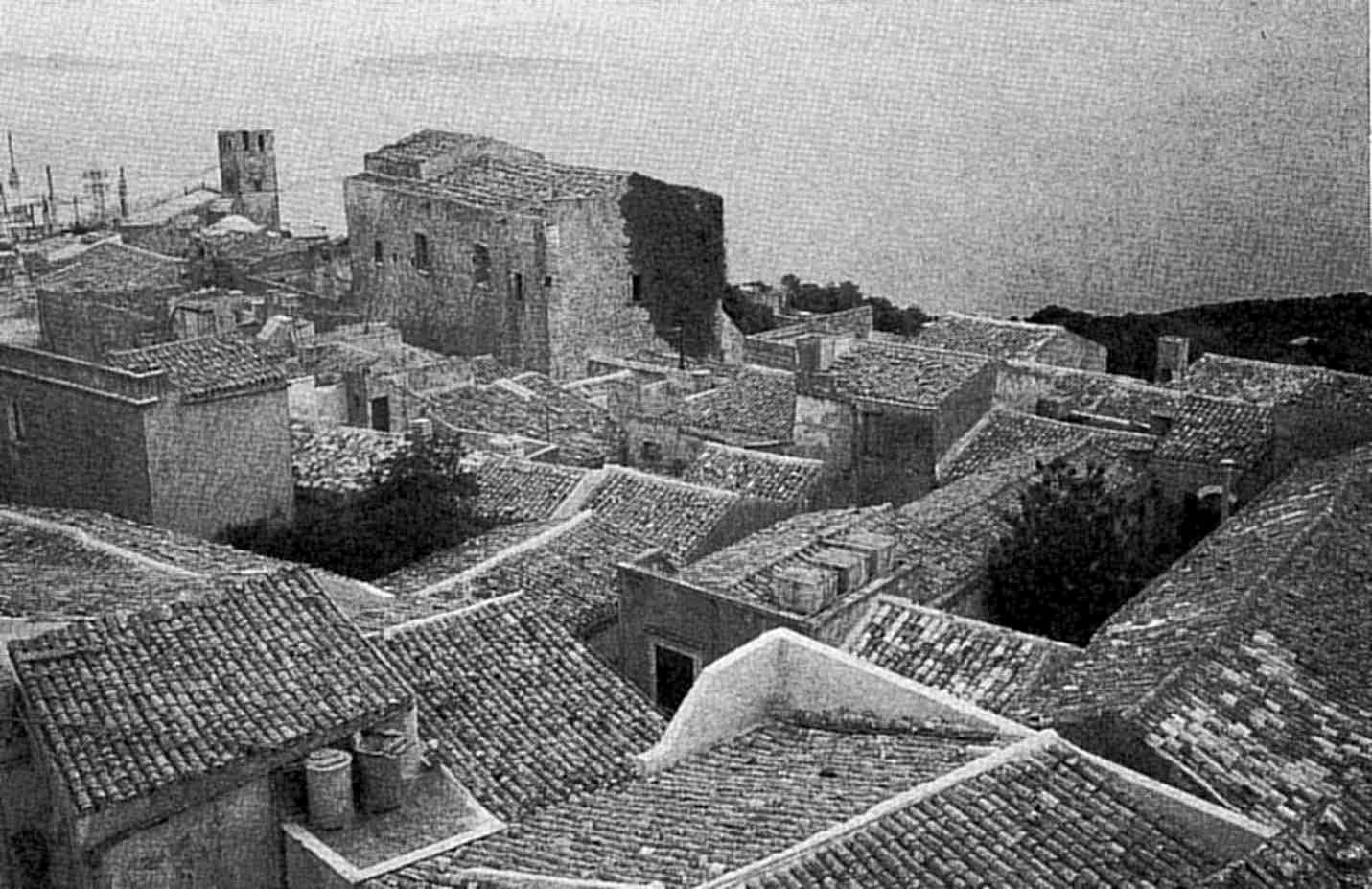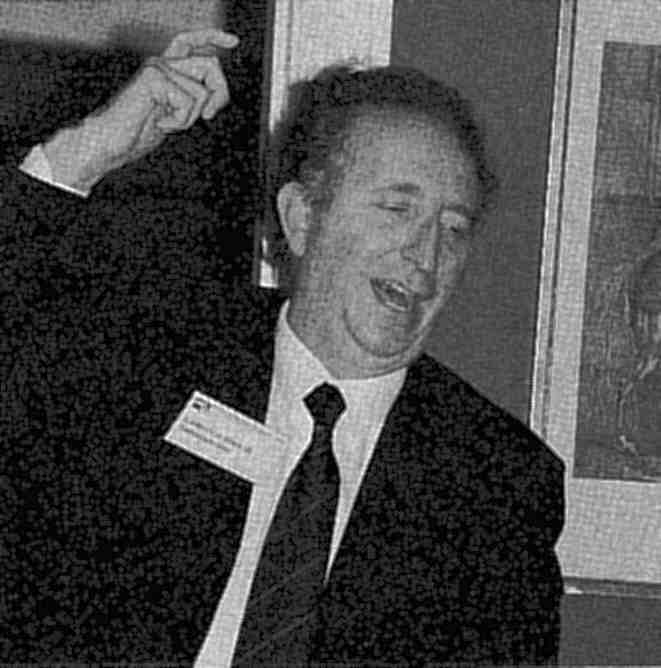
Feature article
Twenty Years of Crystallography in Erice
 Group photo in the courtyard of San Rocco at the 1989 Erice meeting on Molecular Structure and Drug Action. In the front row, Lodovico at left, and Peter Goodford, Program Chair on far right. (Photo courtesy of L. Riva di Sanseverino)
Group photo in the courtyard of San Rocco at the 1989 Erice meeting on Molecular Structure and Drug Action. In the front row, Lodovico at left, and Peter Goodford, Program Chair on far right. (Photo courtesy of L. Riva di Sanseverino)
In March 1974 at the Ettore Majorana Centre in Erice, Sicily, the first course on Crystallography was held and before long, in May 1994, the 21st will be in progress. And all the time Professor Lodovico Riva di Sanseverino has been the lively heart of this continual meeting place for crystallographers.
In 1972 Professor Michael Woolfson, in his dynamical efforts to diffuse Direct Methods within our community, suggested the institution of an International School of Crystallography within the activities of the Ettore Majorana Centre. Lodovico, a Sicilian born "citizen of the world", took the suggestion to heart; the Centre is located in Erice near Trapani, an hour's drive from his birthplace. The Ettore Majorana Centre was established in the sixties by Professor Antonino Zichichi, research director of CERN (Geneva) and professor at Bologna University. In 1963 he started to organize meetings on subnuclear physics in Erice and a few years later he was able to install a permanent staff and named the centre after the very promising young scientist Ettore Majorana who worked with Fermi and disappeared mysteriously when on his way by overnight ferry from Palermo to Naples, where he was to take up his recent appointment as professor of physics. Around 1973 the Ettore Majorana Centre extended its activities to other disciplines and one of the first was crystallography.
The first course on Direct Methods was directed by Michael Woolfson. At the time I myself was a beginning university staff member and I remember that when Herbert Hauptman gave his famous lecture series in Parma in the spring of 1973, Lodovico told me that he was going to Sicily together with Michael, Herbert, Gabriel Germain, and Peter Main to examine a potential conference centre as the venue for a future summer school. He was worried a bit, but without reason as we now know. So, the next spring over 100 crystallographers gathered in the San Giovanni building, with Michael as director and Lodovico as local organizer. And two weeks later we left with many friends for life and a lot of state-of-the-art knowledge. And that is the way it has been ever since; Erice has been a crystallographic brainwash for all 2,370 participants who took part in those 20 courses.
 Typical view from Mt Erice on a clear day. (Photo WLD)
Typical view from Mt Erice on a clear day. (Photo WLD)
Erice is a little town at the top of a (750 m high) mountain at the western-most point of Sicily. It has many monasteries, narrow paved roads, few cars, very old houses, and a much older, religious, military, and cultural history, going back over 3000 years. But at present Erice is no more than a historical site, and real life goes on at the foot of the mountain in Trapani. Most of the 200 odd people living in Erice earn their money at sea level. A few buses descend the 20 hair-pin road in the early morning and return late in the afternoon. The mountain is high enough and near enough to the Mediterranean that clouds often surround its summit in the daytime and an eerie dense fog fills the narrow streets in the evening creating an atmosphere both mystical and magical. Occasionally, nonmountaineers are startled to glimpse a sunny valley through the clouds. Thus, Erice is an ideal spot for summer schools; isolated and magnificent, in a glorious cultural tradition, with rapidly changing weather.
The first course took place in San Giovanni at the edge of the summit plateau with magnificent views in a northwesterly direction. Tea was served on the terrace with the world at our feet. Later the Ettore Majorana Centre had some monasteries near the summit restored and changed its main office to San Rocco. It now has a modern, well-equipped conference centre occupying a number of historical buildings. As a participant it is great to live and work on science in this mix of the past and the present, of archeology and culture.
The Majorana Centre has an ingenious means of providing meals. Participants go with old and new friends to one of the ten restaurants and enjoy the local specialties (sword fish, tuna, pasta al pesto!!). The atmosphere in the restaurants and the splendid local wines stimulate the contacts and conversations, which may well be the most important aspect of the schools.
The directors of the Crystallographic School, originally Dorothy Hodgkin and now Tom Blundell, have been responsible for the selection of topics and the directors of individual courses. The course directors independently select frontier topics that mix crystallography with other exciting disciplines. The first meeting on drug action brought together pharmacochemists, pharmacologists, and crystallographers.
Students from early courses often became invited lecturers in later schools and finally ended as course directors. Examples of such "Erice careers" are Carmelo Giacovazzo, Wayne Henrickson, Judith Howard, and myself.
 Lodovico Riva di Sanseverino, citizen of the world and spirit of Erice. (Photo WLD)
Lodovico Riva di Sanseverino, citizen of the world and spirit of Erice. (Photo WLD)
The reputation of the Crystallographic School is such that courses are typically oversubscribed and have sponsorship from NATO, EC, IUCr, ICSU, and many industries and governments.
The local arrangements directed by Lodovico and Paolo Spadon are just as exceptional as the scientific program. The congenial staff, Pinola, Alberto, Jerry and Maria Zaini, Manuela, Kinka, Franko Giovanna, and students from the School of Tourism in Florence are dedicated to the success of the school and the comfort of the participants. Participants never forget evenings of international songs in the piano room with Marsala and Sicilian cakes andthe banquet in the basement of San Francesco.
Some statistics about "our" school:
- 20 courses in 20 years,
- 2370 participants from 80 nationalities,
- among the invited speakers 15 Nobel laureates, ten of them lecturing in the School before they got the prize,
- subjects running through all of crystallography, from Teaching (nr 4/1977) to synchrotron radiation (nr 12/1985), from Direct Methods (1/1973, 5/1978,10/1984, and 16/1990) to Materials and Crystallography (20/1993) and Crystallography of Molecular Biology (3/1976, 8/1982, 14/1988, and 21/1994),
- 10 courses in the planning stage.
This compares very well with the statistics of the Ettore Majorana Centre itself, with approximately 650 courses in 100 disciplines and 50,000 participants, and 41 Nobel laureates among the lecturers.
To conclude, the crystallographic community is very lucky to have such a continuing school, where so many of us get new ideas and make new scientific friends in courses at the highest level in our discipline. Lodovico, Paola, and Tom, our congratulations with the fourth lustrum.
Henk Schenk


